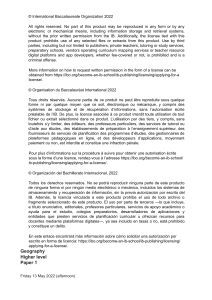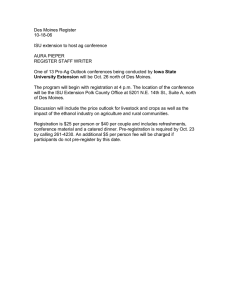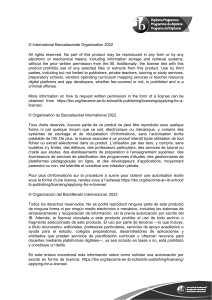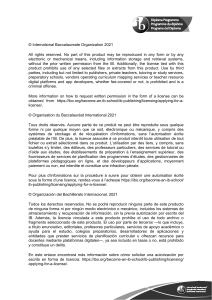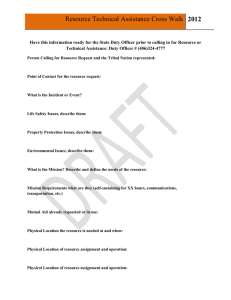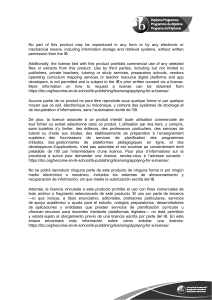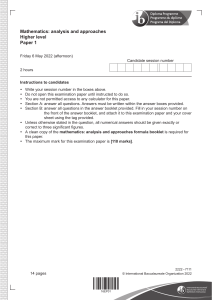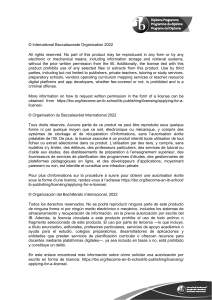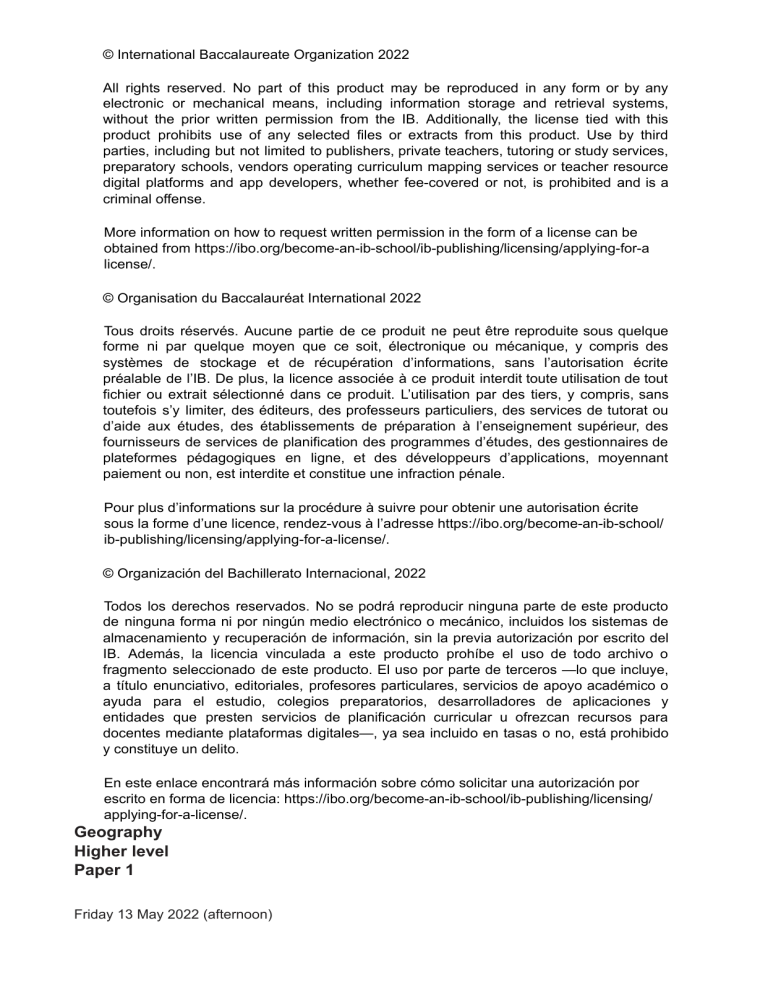
© International Baccalaureate Organization 2022 All rights reserved. No part of this product may be reproduced in any form or by any electronic or mechanical means, including information storage and retrieval systems, without the prior written permission from the IB. Additionally, the license tied with this product prohibits use of any selected files or extracts from this product. Use by third parties, including but not limited to publishers, private teachers, tutoring or study services, preparatory schools, vendors operating curriculum mapping services or teacher resource digital platforms and app developers, whether fee-covered or not, is prohibited and is a criminal offense. More information on how to request written permission in the form of a license can be obtained from https://ibo.org/become-an-ib-school/ib-publishing/licensing/applying-for-a license/. © Organisation du Baccalauréat International 2022 Tous droits réservés. Aucune partie de ce produit ne peut être reproduite sous quelque forme ni par quelque moyen que ce soit, électronique ou mécanique, y compris des systèmes de stockage et de récupération d’informations, sans l’autorisation écrite préalable de l’IB. De plus, la licence associée à ce produit interdit toute utilisation de tout fichier ou extrait sélectionné dans ce produit. L’utilisation par des tiers, y compris, sans toutefois s’y limiter, des éditeurs, des professeurs particuliers, des services de tutorat ou d’aide aux études, des établissements de préparation à l’enseignement supérieur, des fournisseurs de services de planification des programmes d’études, des gestionnaires de plateformes pédagogiques en ligne, et des développeurs d’applications, moyennant paiement ou non, est interdite et constitue une infraction pénale. Pour plus d’informations sur la procédure à suivre pour obtenir une autorisation écrite sous la forme d’une licence, rendez-vous à l’adresse https://ibo.org/become-an-ib-school/ ib-publishing/licensing/applying-for-a-license/. © Organización del Bachillerato Internacional, 2022 Todos los derechos reservados. No se podrá reproducir ninguna parte de este producto de ninguna forma ni por ningún medio electrónico o mecánico, incluidos los sistemas de almacenamiento y recuperación de información, sin la previa autorización por escrito del IB. Además, la licencia vinculada a este producto prohíbe el uso de todo archivo o fragmento seleccionado de este producto. El uso por parte de terceros —lo que incluye, a título enunciativo, editoriales, profesores particulares, servicios de apoyo académico o ayuda para el estudio, colegios preparatorios, desarrolladores de aplicaciones y entidades que presten servicios de planificación curricular u ofrezcan recursos para docentes mediante plataformas digitales—, ya sea incluido en tasas o no, está prohibido y constituye un delito. En este enlace encontrará más información sobre cómo solicitar una autorización por escrito en forma de licencia: https://ibo.org/become-an-ib-school/ib-publishing/licensing/ applying-for-a-license/. Geography Higher level Paper 1 Friday 13 May 2022 (afternoon) 45 minutes Instructions to candidates ⮹ Do not open this examination paper until instructed to do so. ⮹ Answer the questions in one option. ⮹ The accompanying geography resource booklet is required for this examination paper. ⮹ The maximum mark for this examination paper is [20 marks]. Option Questions Option A — Freshwater 1–2 Option B — Oceans and coastal margins 3–4 Option C — Extreme environments 5–6 Option D — Geophysical hazards 7–8 Option E — Leisure, tourism and sport 9–10 Option F — Food and health 11–12 Option G — Urban environments 13–14 10 pages 2222–5201 © International Baccalaureate Organization 2022 – 2 –2222–5201 Blank page – 3 –2222–5201 Answer the questions in one option. When relevant, answers should refer to case studies or examples, and where appropriate include well‑drawn maps or diagrams. Option A — Freshwater Answer the following question. 1. Refer to the diagram on page 3 of the accompanying resource booklet. The graph shows who has responsibility for collecting water from outside the home in countries where a high percentage of rural households lack access to piped water. (a) (i) State the number of countries where more than 60% of rural households rely on water from outside the home. [1] (ii) Identify the country where men and women have equal responsibility for collecting water from outside the home. [1] (b) Outline one environmental impact of increased human pressure on aquifers. [2] (c) Explain two ways in which water can be managed to provide a more sustainable future for local communities in countries such as these. [3 + 3] Answer either part (a) or part (b). Either 2. (a) Examine why geographers use a systems approach in the study of drainage basins. [10] Or 2. (b) Examine how conflicts between different stakeholders in the management of wetlands might be resolved. [10] End of Option A Turn over – 4 –2222–5201 Option B — Oceans and coastal margins Answer the following question. 3. Refer to the map on pages 4–5 of the accompanying resource booklet. The map shows the pattern of movement of oil tankers and their chokepoints. (a) (i) Identify the chokepoint with the most barrels of oil moved per day. [1] (ii) State the number of millions of barrels of oil moved per day at the Strait of Malacca choke point. [1] (b) Outline one reason why the ownership of one named ocean area or territory is contested. [2] (c) Suggest one political challenge and one environmental challenge associated with the movement of oil around the globe by sea. [3 + 3] Answer either part (a) or part (b). Either 4. (a) Examine the major threats to coral reef environments. [10] Or 4. (b) Examine why conflicts often develop over the commercial use of coastal margins. [10] End of Option B – 5 –2222–5201 Option C — Extreme environments Answer the following question. 5. Refer to the map on pages 6–7 of the accompanying resource booklet. The world map shows the production of desalinized water in selected countries which include hot, arid areas. (a) (i) Estimate the desalination capacity of the United States, in thousands of cubic metres per day. [1] (ii) State the country shown on the map with the smallest desalination capacity. [1] (b) Outline one reason why some semi-arid areas with low annual rainfall are considered to be extreme environments. [2] (c) Explain two ways in which solar power can help the sustainable development of communities in hot, arid areas such as these. [3 + 3] Answer either part (a) or part (b). Either 6. (a) Examine the possible long-term challenges associated with tourism in one or more types of cold environment. [10] Or 6. (b) Examine the importance of wind in the development of two or more hot, arid landscape features. [10] End of Option C Turn over – 6 –2222–5201 Option D — Geophysical hazards Answer the following question. 7. The graph shows the magnitude of selected earthquake events in relation to the number of deaths caused. 1 000 000 Indian Ocean (2004) Haiti (2010) 100 000 m u N 10 000 1000 100 Nepal (2015) s Japan (2011) ht a e China (2008) d f o r Indonesia (2005) e USA (1964) b Mexico (2017) 10 Chile (2015) 1 6.5 7.0 7.5 8.0 8.5 9.0 9.5 Magnitude (Richter scale) (a) (i) Identify the location of the earthquake event with the highest magnitude. [1] (ii) State the number of deaths caused by the earthquake event in the USA. [1] (b) Outline one reason why high-magnitude earthquake events do not occur very often. [2] (c) Explain how the risk to a community from earthquake events such as these might be affected by: (i) the age structure of its population; [3] (ii) political factors (governance of the country). [3] (Option D continues on the following page) – 7 –2222–5201 (Option D continued) Answer either part (a) or part (b). Either 8. (a) Examine the severity of the impacts of different types of mass movement on human well-being. [10] Or 8. (b) Examine the effectiveness of technology and planning strategies in reducing human vulnerability to volcanic hazards. [10] End of Option D Turn over – 8 –2222–5201 Option E — Leisure, tourism and sport Answer the following question. 9. Refer to the photograph on page 8 of the accompanying resource booklet. The photograph shows a football stadium in South America. (a) Using the photograph, identify two characteristics of this area that may reduce accessibility for visiting football supporters. [1 + 1] (b) Outline one reason why some city stadiums have a large sphere of influence. [2] (c) Suggest how large numbers of visitors in an area such as this could have: (i) one positive economic impact for local communities; [3] (ii) one negative economic impact for local communities. [3] Answer either part (a) or part (b). Either 10. (a) Examine why views may differ on the benefits of tourism as a development strategy. [10] Or 10. (b) Examine the influence of cultural and political factors on participation in sport at varying scales. [10] End of Option E – 9 –2222–5201 Option F — Food and health Answer the following question. 11. Refer to the graph on page 9 of the accompanying resource booklet. The graph shows the incidence of dengue fever (a vector-borne disease) in an Asian country between 2010 and 2012 by age group. (a) (i) State the age group which had the highest incidence of dengue fever in 2012. [1] (ii) Estimate the mean incidence rate of dengue fever for all years in the 20–24 age group. [1] (b) Outline one strategy used to limit the spread of a water-borne disease. [2] (c) Explain how using genetically modified organisms (GMOs) to increase food production can lead to: (i) one environmental disadvantage; [3] (ii) one social disadvantage. [3] Answer either part (a) or part (b). Either 12. (a) Examine how food production systems can use water and energy more sustainably. [10] Or 12. (b) Examine how different stakeholders influence the diets of individuals and societies. [10] End of Option F Turn over – 10 –2222–5201 Option G — Urban environments Answer the following question. 13. Refer to the topographic map on pages 10–11 of the accompanying resource booklet. The topographic map shows the small town of Queenstown in New Zealand. Founded in the 1860s this town has experienced rapid growth since then. The scale of the map is 1:50000. (a) (i) Identify the state highway located in grid reference 6105. [1] (ii) State one physical reason for the location of the airport to the east of Frankton (Queenstown Airport). [1] (b) Outline one reason why land values are higher in some parts of an urban area. [2] (c) Explain two challenges associated with making infrastructure improvements in urban settlements such as Queenstown. [3 + 3] Answer either part (a) or part (b). Either 14. (a) Examine the strengths and weaknesses of resilient city design as a way of managing climatic challenges. [10] Or 14. (b) Examine why social deprivation occurs for different reasons in urban areas at varying stages of development. [10] End of Option G References: © International Baccalaureate Organization 2022
